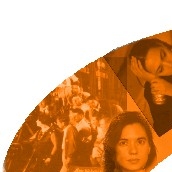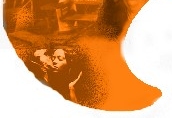


| Course M, 2:30-5:20 W, 2:30-4:20 Thomson 125 |
| Instructor K. Gillis-Bridges Padelford A305 543-4892 MW, 1:00-2:20 |
| Page last updated 12/9/02 |

Sample Essay
Kathryn Bigelow’s Blue Steel and Amy Heckerling’s Clueless have little in common as far as genre, style or plot are concerned. However, both movies help to deconstruct gender roles employing completely opposite tactics. While Bigelow explodes gender from the inside by infiltrating the male genre with her female lead, Heckerling mocks gender by positioning her audience as outsiders looking in at her fluffily feminine protagonist in disbelief.
Blue Steel’s Megan Turner is an unlikely female heroine for a movie made in 1990. In a time when most action movies (especially cop genre) had male protagonists (with occasional token women-sidekicks who died early in a film along with token black sidekicks), Turner’s presence is extremely subversive. Cher from Clueless on the other hand is such a caricature of femininity that the movie seems to call into question gender-performing in a way reminiscent of Agnes Varda’s Cleo From 5 to 7. It is fascinating how both directors handle their lead characters without falling into offensive cinematic conventions: Megan Turner is not a sexually objectified butt-kicking “babe” (unlike many action movie heroines) and Cher is not a dehumanized “bimbo” (unlike a lot of similar characters).
In their portrayal of women most films can be summarized as soft-core porn for heterosexual men. In such heterosexist environment most female characters exist only as various sexual “types” to satisfy diverse sexual tastes of heterosexual men. This objectification of women informs most movies, even the ones with strong female characters. Independence and strength of such heroines functions mostly to sexually tantalize slightly masochistic heterosexual men. This sexual objectification is achieved through casting conventionally beautiful, stereotypically feminine actresses in lead roles, keeping these heroines scantily dressed throughout a movie and otherwise downplaying the threat of independent women to the patriarchal society while exaggerating the sexual dominatrix factor. Blue Steel does none of the above. Androgynous Jamie Lee Curtis is cast as Turner, which by itself complicates the gender dynamics -- the actress who looks like a boy is dressed as a man (in a traditionally male uniform) through most of the film. Throughout the film, Bigelow messes with our minds. In the beginning we see a male cop after a male cop pose with their wives and children, followed by Turner posing with her female friend who tells her that she loves Turner. In a different setting this scene wouldn’t look curiously homoerotic, but with Turner already taking on stereotypically male job (and clothing) it does. It is important to remember that it is the same friend, Tracy who later cooks for Turner and who serves as a stereotypical catalyst for the cop genre -- the girlfriend victim who needs to be avenged. Interestingly, Tracy is a different kind of “girlfriend”: she is not “the protagonist’s woman” but her best friend. In the scene that follows Turner encounters two women (most likely sex workers) on the street in what can either be seen as a homosexual flirting or a subtle female bonding--we see “masculinized” Turner smile as the two very feminine women “check her out.“
What makes Turner’s character even more unconventional is her unspoken feminist leanings. Her desire to be a cop is connected to the domestic abuse she has witnessed in her family. We even see her arrest her father for abusing her mother. Near the end of the film Turner finally gives a straightforward answer to the question about her career choice. She says “Him” is what made her want to become a cop. “Him” is of course Eugene but also her father and metaphorically speaking all men. Turner’s feeling of comradeship with womankind positions her as a undercover-feminist infiltrator among her male colleagues and within misogynistic society as a whole. Eugene, on the other hand, is a representative of “girls kick butt” genre’s heterosexual male audience. But now he is the one to be looked at and objectified: he is stripped of his manhood, dehumanized and killed like some sort of monster or a beast, while his sexual taste (for a “butt-kicking babe“ I described above) is pathologized. It seems that Bigelow is turning the table on misogyny which in so many films is poorly disguised as female action heroes. Turner refuses to play Eugene’s game, to be his dominatrix. She is not strong to turn men on. She is strong to defend other women. Furthermore, all heterosexual options are problematized in the film. For example, the only time Turner is undressed and sexualized is during her love scene with Mann (who is slightly bestial in the scene--making slurping sounds on her body). And it is that love scene which makes her vulnerable--Mann is soon replaced by clearly bestial Eugene who is trying to rape her. It is unlikely that Bigelow’s juxtaposing of misogynistic (but sort of good) cop and a perverted serial killer was unintentional. It seems that in Blue Steel Turner’s heterosexuality is “punished” the same way homosexuality and female independence were and are traditionally punished in films.
In Clueless it’s not Cher but the audience who are positioned on the outside. This allows us to be the spectators not only of the movie but of Cher’s Victorian hyperfemininity. Of course, such outside gaze could easily turn Clueless into a very sexist movie. There are a lot of comedies where “laughing at” turns into condescending. Instead, Heckerling and especially Silverstone make Cher so sympathetic and human that we as an audience can fall in love with her while laughing at her gender-overperforming. Cher’s shallow femininity is a direct result of her ignorance. At the same time her slightly Victorian appearance is a result of her privileged upbringing. For example, when her father notes how much “she takes care of him” we are left to wonder what exactly he means. We know that all the stereotypically female chores associated with maintaining the household and nurturing the family are performed by Lucy “who doesn’t speak English." Perhaps, he is talking about her constant nagging about him eating healthy. This “look pretty” and “caring” attitude for upper-class women does fit the Victorian era’s standards of femininity. However, Cher’s Victorianism is problematized, because while Victorian values were largely supported by Anglo-colonial pride and Christianity, Cher is Jewish and has a multiracial mix of friends and classmates.
The male characters in Clueless also undermine traditional gender roles. Most boys with their macho bravado (the best example is Dionne’s boyfriend) seem as silly in their gender-performance as Cher. Furthermore, they don’t interest Cher. Unlike Cher, who only appears shallow on the surface as a part of her gender role-playing, Elton is a cunning snob who tries to get into Cher’s pants, and after failing to do so, leaves her alone in the dangerous part of the city. Josh and Travis are the only two pleasant heterosexual men and not surprisingly they’re both demasculinized in their appearance and soft-spoken demeanor. They’re sensitive and gentle men, positioned outside of their baggy-pants-wearing macho generation and aligned, instead, with hippy men of the 60’s who were by all accounts in touch with their feminine side. This is done in a very subtle way--Josh chooses a less testosterone-driven but socially-conscious branch of the law while Travis has long hair, smokes pot and is very genuine. Finally, the most interesting male character is Christian who embodies 1950’s true gentlemenship (he is the only one we see performing the traditionally masculine job of defending a woman) but who is gay. Considering that at the time Christian was a unique gay character in cinema--a “perfect man”--the impact of Clueless on popular culture in regards to gender and sexuality shouldn’t be underestimated. His character popularized the idea of best gay friend on screen spawning countless variations on the theme and bringing the subject of male homosexuality (however tamely) into popular culture in a very favorable light. His presence in Clueless subverts our heterosexist expectations and further problematizes Cher’s outdated hyperfemininity.
Bigelow’s film plays with gender while bringing to life a rare character for cinema: a truly feminist heroine (who even doesn‘t die in the end). Heckerling’s picture underscores the fakeness of her protagonist’s femininity while playfully sorting out her limited heterosexual options.
Copyright 2002 Wes Naumenko
Essay may not be reproduced in any form without
the express permission of the author.
Essay may not be reproduced in any form without
the express permission of the author.